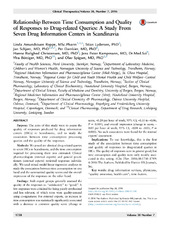Relationship Between Time Consumption and Quality of Responses to Drug-Related Queries: A Study From Seven Drug Information Centers in Scandinavia
Reppe, Linda Amundstuen; Lydersen, Stian; Schjøtt, Jan; Damkier, Per; Christensen, Hanne Rolighed; Kampmann, Jens Peter; Böttiger, Ylva; Spigset, Olav
Peer reviewed, Journal article
Published version

Åpne
Permanent lenke
https://hdl.handle.net/1956/15771Utgivelsesdato
2016-07Metadata
Vis full innførselSamlinger
Originalversjon
https://doi.org/10.1016/j.clinthera.2016.05.010Sammendrag
Purpose: The aims of this study were to assess the quality of responses produced by drug information centers (DICs) in Scandinavia, and to study the association between time consumption processing queries and the quality of the responses. Methods: We posed six identical drug-related queries to seven DICs in Scandinavia, and the time consumption required for processing them was estimated. Clinical pharmacologists (internal experts) and general practitioners (external experts) reviewed responses individually. We used mixed model linear regression analyses to study the associations between time consumption on one hand and the summarized quality scores and the overall impression of the responses on the other hand. Findings: Both expert groups generally assessed the quality of the responses as “satisfactory” to “good.” A few responses were criticized for being poorly synthesized and less relevant, of which none were quality-assured using co-signatures. For external experts, an increase in time consumption was statistically significantly associated with a decrease in common quality score (change in score, –0.20 per hour of work; 95% CI, –0.33 to –0.06; P ¼ 0.004), and overall impression (change in score, – 0.05 per hour of work; 95% CI, –0.08 to –0.01; P ¼ 0.005). No such associations were found for the internal experts’ assessment. Implications: To our knowledge, this is the first study of the association between time consumption and quality of responses to drug-related queries in DICs. The quality of responses were in general good, but time consumption and quality were only weakly associated in this setting.
